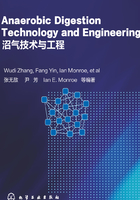
Preface
Biogas technology plays a unique role in the treatment processes of organic solid disposal and waste water, and it is an effective way of reusing of organic wastes, such as energy recovery from wastes. Over the past 100 years, the theoretical development of biogas technology has brought about numerous techniques in a wide prospect. More than 40 years of application in China, household biogas digesters play an important role in solving problems concerning rural and agricultural sustainable development in developing countries (e.g. making up for shortage of rural energy). From the perspective of energy development, biogas technology, as a zero-CO2-emission-technology, generates energy with decomposed organic wastes which can cause environmental pollution, and doesn't emit CO2in atmosphere. Rural biogas application has provided remarkable benefits concerning society, ecology, energy and economy, and the comprehensive utilization of biogas and its residue has formed different ecological agriculture modes such as the “four in one” mode in north of China and “pig-biogas-fruits” mode in south of China, and these modes reflect the reasonable connotation of sustainable agriculture, which is future way of agriculture development in developing countries. At present, rural household biogas digester popularizes rapidly, and many government agencies, international organizations and NGOs in the world have been devoted to construction of biogas in developing countries. In 2007, Netherlands government raised 2 billion euros in the world to install 2 million rural household biogas digesters in Africa, and then, Asian Bank established a plan of promoting 0.15 million household biogas digester in 15 countries of Asia (in this plan, Asian Bank provide 1/3 subsidy funds and 1/3 loans).
Facing the fossil fuels crisis and environment deterioration, biogas, as a kind of renewable energy, has been attached to great importance in many developed countries. In Europe, large biogas projects develop rapidly, and its scale becomes bigger over time, and the ratio of biogas in the energy consumption is rising. Large and medium-size biogas projects are widely used to treat different pollutants (e.g. livestock and poultry breeding waste water, industry organic waste water, kitchen waste, sewage and domestic waste) to realize pollution control, energy recovery,resource utilization. In nature, organic material is decomposed through two biochemical ways, i.e. anaerobic and aerobic processes. Compared to aerobic technology, anaerobic process has many advantages such as: ①anaerobic fermentation can withstand the high concentration of organic load; ②energy consumption of this process is only 1/10 of the aerobic process; ③the amount of sludge of this process is far less than the aerobic treatment; ④this kind of fermentation can bring economic profits (resulting from biogas and organic fertilizer) as well as environmental benefit. Therefore, anaerobic digestion technology has been widely used to treat high concentration organic waste water and waste, and promote the development of high yield, high quality, highly effective, ecology and safety agriculture.
By anaerobic digestion, pathogenic bacteria and eggs in organic waste can be killed, and biogas slurry (as a kind of efficient and safety organic fertilizer) can be produced, and refractory pesticides such as DDT can be effectively degraded. Generally, Biogas technology and engineering can: ①convert excrement to resources, promote the sustainable development of animal husbandry; ②develop green agriculture by using biogas fermentation residues as fertilizer; ③realize energy recovery; ④treat waste water, recycle irrigation and realize zero discharge.
This book is a systematical summary of author's practice of nearly 30 years and 5 years training materials that were prepared for biogas technology international training workshops which were supported consecutively by Ministry of Science and Technology of China and Yunnan Provincial Science and Technology Department from 2008 to 2012. Based on a large number of domestic and foreign literatures, this book tries to build the systematical theory, show detailed technology and process, and display latest research results. So, this book has readability and practicability.
In the process of writing, the authors got the care and help from leaders and colleagues, the understanding and support from family. The publication of this book also condensed the hard work of chemical industry press editors. So, by the publication of this book, I want to express my heartfelt thanks for all people and units above.
Because of our limitations, the omissions are inevitable, sincerely welcome criticisms from relevant experts and readers.
Wudi Zhang
On February 26, 2016